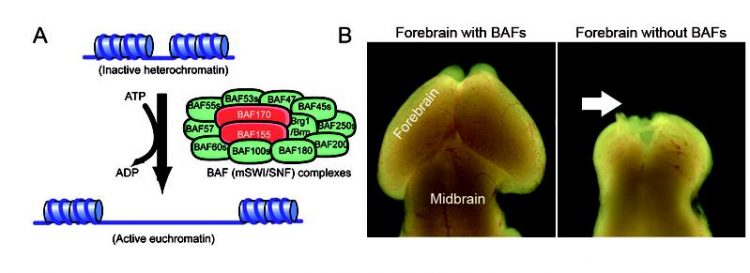The impact of epigenetics on brain development

Chromatin remodeling activity and functionality of BAF complexes in forebrain development. (A) The multi-subunit BAF complex alters the chromatin structure in an energy-consuming process. By local reorganization from inactive heterochromatin to the active form (euchromatin), single genes become accessible by activating or repressing transcription factors. (B) The proteins BAF155 and BAF170 serve as scaffolding subunits to maintain the stability of the entire BAF complex. The forebrain structure is not formed in deletion mutants that lack these factors. Tuoc / CNMPB
In mammals, neurogenesis is mainly restricted to development. However, certain regions of the forebrain have the capability of generating new neurons also in the adulthood. Key mechanism is the so-called epigenetics and chromatin remodeling, which controls the expression of genes and triggers the differentiation of neuronal stem cells.
However, there is little information on how epigenetic programs and chromatin regulation exactly interact to control the fate of neural stem cells. Scientists of the Göttingen Cluster of Excellence and the DFG Research Center for Nanoscale Microscopy and Molecular Physiology of the Brain (CNMPB) at the University Medical Center Göttingen (UMG), the Max Planck Institute for Biophysical Chemistry (MPIbpc) and the German Center for Neurodegenerative Diseases (DZNE) gained striking new insight into the role of the chromatin remodeling multi-subunit BAF complex in forebrain development.
The scientists, for the first time provide evidence for a molecular mechanism that involves the BAF complex to control global epigenetic programs and gene expression programs. The findings have been published recently in the Cell Reports journal.
Original publication: Narayanan R, Pirouz M, Kerimoglu C, Kiszka K, Pham L, Wagener R, Rosenbusch J, Kessel M, Fischer A, Stoykova A, Staiger JF, Tuoc T (2014) Loss of the entire multi-subunit BAF (mSWI/SNF) complexes impairs global epigenetic programs in forebrain development. CELL REPORTS, 13(9): 1842-54.
One of the major challenges in neurobiology is to understand how the fate of neural stem cells is controlled. During brain development, the BAF multi-protein complex acts as the central relay station for the activation of differentiation programs to generate neural cells from neural stem cells. Remodeling of the chromatin structure is initiated by interaction of the complex with specific genomic sequences.
Inactive, condensed heterochromatin is converted into the active loosely packed form (euchromatin), making genes accessible for activation or inactivation by transcription factors, which are involved in neuronal differentiation processes. Areas in the genome, which are subjected to chromatin remodeling, are determined by a priori chemical modification mediated by epigenetic influences.
A full understanding of how the BAF complex exactly influences the fate of neuronal stem cells has been hindered by the absence of mutant models completely lacking BAF complexes. Here the scientists have been able to create knockout mutants lacking the entire BAF complex.
The result: The subunits BAF150 und BAF170 are central key factors, acting as scaffolding proteins for the interaction with the up to 15 subunits of the functional complex. These subunits serve as regulators of stability and functionality of the BAF complex, as indicated by a massive impairment of the murine forebrain development in BAF155/BAF170 deletion mutants.
Together with a dramatic reduction in active euchromatin, the loss of functional BAF-complexes resulted in a comprehensive decrease of gene expression events. Simultaneously, the scientists observed a global increase in repressive heterochromatin marks. The authors conclude: BAF complexes rather influence repression mechanism in neuronal cells indirectly than directly activate gene expression programs.
To be able to quickly activate the differentiation to neural cells during brain development, specific genes are maintained in a certain state. This state is significantly controlled by the presence of certain epigenetic markers, which trigger or repress transcription processes. During brain development, the BAF complex interacts with theses markers to support the switch from the inactive condition to the active state and thus initiates chromatin remodeling.
Tran Tuoc, senior author of the study, is convinced: “These findings improve our understanding of the epigenetic and chromatin remodeling as regulators of neuronal stem cell-fate and developmental plasticity. They may help to design new strategies for enhancing brain repair, e.g. in neurodegenerative disorders.”
Weitere Informationen:
http://www.neuroanatomie.uni-goettingen.de/en/home – Homepage of the Institute of Neuroanatomy, University Medical Center Göttingen
http://www.cnmpb.de – Cluster of Excellence and DFG Research Center for Nanoscale Microscopy and Molecular Physiology of the Brain (CNMPB)
Media Contact
All latest news from the category: Life Sciences and Chemistry
Articles and reports from the Life Sciences and chemistry area deal with applied and basic research into modern biology, chemistry and human medicine.
Valuable information can be found on a range of life sciences fields including bacteriology, biochemistry, bionics, bioinformatics, biophysics, biotechnology, genetics, geobotany, human biology, marine biology, microbiology, molecular biology, cellular biology, zoology, bioinorganic chemistry, microchemistry and environmental chemistry.
Newest articles

First-of-its-kind study uses remote sensing to monitor plastic debris in rivers and lakes
Remote sensing creates a cost-effective solution to monitoring plastic pollution. A first-of-its-kind study from researchers at the University of Minnesota Twin Cities shows how remote sensing can help monitor and…

Laser-based artificial neuron mimics nerve cell functions at lightning speed
With a processing speed a billion times faster than nature, chip-based laser neuron could help advance AI tasks such as pattern recognition and sequence prediction. Researchers have developed a laser-based…

Optimising the processing of plastic waste
Just one look in the yellow bin reveals a colourful jumble of different types of plastic. However, the purer and more uniform plastic waste is, the easier it is to…



